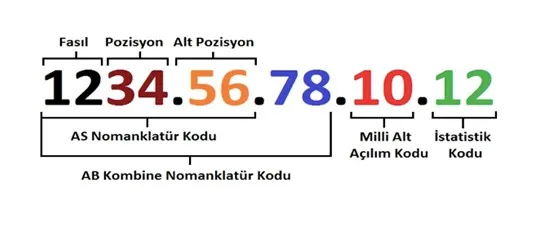
Things You Need to Know About Customs Tariff Statistical Position
The customs duties applied in foreign trade and on imported products are determined by the HTS code. The HTS, an international standard system for tracking each product's customs duty and other trade policy data, enables the classification of products. This classification is very important for determining the cost of import transactions in terms of customs duties.
One of the data points that need to be identified in cost research for planning an import transaction in advance is the tax rates of the product to be imported. The diversity of products subject to foreign trade can cause confusion with all product names, making it inevitable to classify these products according to a specific tariff. The HTS code facilitates the identification of each product and the determination of customs duty rates, reducing uncertainties in trade. Therefore, the HTS code is considered a fundamental element of foreign trade.
What Is the Customs Tariff Statistical (HTS Code) Position?
The customs tariff statistical position is based on the harmonized system nomenclature created by the World Customs Organization to eliminate discrepancies caused by different countries' product classifications in foreign trade.
This regulation aims to ensure uniformity in customs procedures. The customs tariff schedule contains customs tariffs determined according to the harmonized system. Each product has a code number assigned for customs procedures. The customs tariff statistical position is the general name for the code numbers created according to the harmonized system and based on a 10-digit system in the tariff schedule.
These positions provide a standardized classification structure used in foreign trade and ensure products are defined uniformly in customs procedures. This helps prevent confusion and discrepancies during customs processes. The Customs Tariff Statistical Position plays an important role in ensuring that product classifications used in international trade are unified and standardized.

What Is the HTS Position Number?
An HTS code is defined as a 12-digit number. Each digit is named separately.
- •• 2 digits: Chapter number
- ••.•• 4 digits: Position number
- ••••.•• 6 digits: Alternative Position Number (Harmonized System Nomenclature Code)
- ••••.••.•• 8 digits: Combined Nomenclature code used by European Union countries
- ••••.••.••.•• 10 digits: National Detailed Code
- ••••.••.••.••.•• 12 digits: Customs Tariff Statistical Position code
How to Learn the HTS Code?
You need to enter the product name, HTS Description, and HTS number into the relevant box. When you enter this information, you can find out your HTS code.
Customs Tariff Statistical Position Inquiry
The Customs Tariff Statistical Position Inquiry or abbreviated as HTS code inquiry is a service used to learn the classification and tax rate of a product in the customs tariff. Thanks to the HTS code inquiry, the customs duty amount and other details of a product classified according to its production level and material type or its function or usage purpose can be learned. This service has a significant impact on foreign trade and supports the regulation of trade.
If you are wondering where to perform the inquiry, you can search for your HTS code by browsing websites such as Turkey Exporters Assembly and Tariff Search Engine.
How to Obtain the HTS Code?
There are multiple sources. You can easily access the relevant information through the TÜİK website. Follow these steps by visiting the Turkish Statistical Institute’s website:
- To find the description of the material, go to the “Description Search” section on the website and select HTS 2023 in the “Classification” tab.
- Click the search button and search for a word that accurately describes your product and material.
- Select the most appropriate code and define the description of the material.
- Under the main code, there may be many descriptions. You should make a careful choice based on the material and product features.
- After 6 digits, 2-digit codes allow for more detailed identification of the product. Determine the most suitable code for your product.
Uses of the HTS Code
The product list for customs is determined according to the HTS code, and this code is used for determining companies’ customs duties, product inspection related to foreign trade, taxes applied during transportation, origin rules, and tax determination. Especially for companies engaged in foreign trade, the use of the HTS code is very important because it allows customs procedures to be carried out more quickly and accurately. Additionally, the HTS code plays a significant role in regulating and taxing trade between countries. Therefore, companies need to define their products according to HTS codes and conduct customs procedures based on these codes.
Interested? What is Lowbed Transportation?


